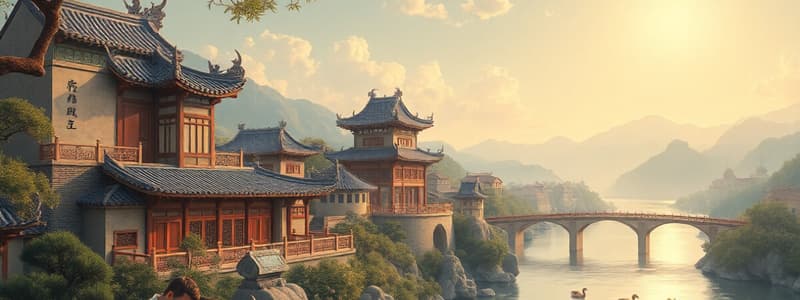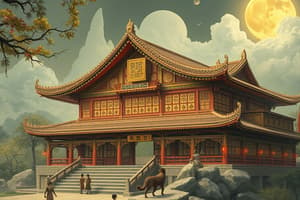Podcast
Questions and Answers
The Chinese excelled in making a delicate pottery called ______.
The Chinese excelled in making a delicate pottery called ______.
porcelain
Silk production, known as ______, was a closely guarded secret by the Chinese.
Silk production, known as ______, was a closely guarded secret by the Chinese.
sericulture
The Chinese were the first to grow ______ as a stimulating beverage.
The Chinese were the first to grow ______ as a stimulating beverage.
tea
The ______ was a counting machine developed by the Chinese.
The ______ was a counting machine developed by the Chinese.
Unlike other ancient civilizations, the Chinese civilization did not experience a period of ______.
Unlike other ancient civilizations, the Chinese civilization did not experience a period of ______.
The Chinese civilization began to flourish along the banks of the river ______, in northern China, around 1700 BCE.
The Chinese civilization began to flourish along the banks of the river ______, in northern China, around 1700 BCE.
The earliest Chinese kingdom was that of the ______ dynasty (1700-1027 BCE).
The earliest Chinese kingdom was that of the ______ dynasty (1700-1027 BCE).
By the 14th century BCE, a vibrant civilization had developed here, comparable to that of ______ and Egypt.
By the 14th century BCE, a vibrant civilization had developed here, comparable to that of ______ and Egypt.
During the Shang and Chou dynasties, Chinese society was broadly divided into two classes: the nobles and the ______.
During the Shang and Chou dynasties, Chinese society was broadly divided into two classes: the nobles and the ______.
From the 3rd century BCE, during the Chin dynasty, society became more complex with the rise of ______.
From the 3rd century BCE, during the Chin dynasty, society became more complex with the rise of ______.
A very important characteristic of Chinese society was the close-knit ______.
A very important characteristic of Chinese society was the close-knit ______.
Agriculture was the main occupation, and by around 500 BCE, ______ were dug to direct water to the fields.
Agriculture was the main occupation, and by around 500 BCE, ______ were dug to direct water to the fields.
By 400 BCE, the Chinese were using ______-drawn wooden ploughs for farming.
By 400 BCE, the Chinese were using ______-drawn wooden ploughs for farming.
The Chinese domesticated animals not only for use in agriculture, but also for ______ and food.
The Chinese domesticated animals not only for use in agriculture, but also for ______ and food.
Trade between ancient China and the rest of the world took place largely along the ______ Route.
Trade between ancient China and the rest of the world took place largely along the ______ Route.
The Silk Route had three main branches-a northern one to the Black Sea; a central one to ______ and the Mediterranean Sea; and a southern one to Afghanistan, Iran and India.
The Silk Route had three main branches-a northern one to the Black Sea; a central one to ______ and the Mediterranean Sea; and a southern one to Afghanistan, Iran and India.
The Chinese sold silk, ceramic, fur, jade, and ______ to other countries.
The Chinese sold silk, ceramic, fur, jade, and ______ to other countries.
The horse-drawn ______ was widely used for transport.
The horse-drawn ______ was widely used for transport.
The practice of writing was very important for the ancient Chinese, who initially represented each word with a ______.
The practice of writing was very important for the ancient Chinese, who initially represented each word with a ______.
Confucius was a great philosopher of China who lived in the ______ century BCE.
Confucius was a great philosopher of China who lived in the ______ century BCE.
Towards the end of the Han dynasty in the ______ century CE, Buddhism became more popular in China.
Towards the end of the Han dynasty in the ______ century CE, Buddhism became more popular in China.
The ancient Chinese developed the compass and other astronomical instruments that were fairly ______.
The ancient Chinese developed the compass and other astronomical instruments that were fairly ______.
The Chinese discovered gunpowder around ______ CE.
The Chinese discovered gunpowder around ______ CE.
Ancient Chinese architecture was guided by rules laid down by Chinese ______ like Tao and Confucius.
Ancient Chinese architecture was guided by rules laid down by Chinese ______ like Tao and Confucius.
An important feature of Chinese architecture was the ______, built by the Buddhists to keep sacred relics.
An important feature of Chinese architecture was the ______, built by the Buddhists to keep sacred relics.
The Great Wall, an ancient fortification, stretches for almost ______ kilometres from east to west.
The Great Wall, an ancient fortification, stretches for almost ______ kilometres from east to west.
The Chinese had also invented block printing by ______ CE.
The Chinese had also invented block printing by ______ CE.
Flashcards are hidden until you start studying
Study Notes
Overview of Chinese Civilization
- Chinese civilization flourished along the Huang He river around 1700 BCE.
- Geographic isolation due to the Gobi Desert, Yangtze River, and Himalayas facilitated unique cultural development.
Early Settlements and Agriculture
- Rich silt from Huang He enabled agriculture, leading to permanent settlements.
- Towns and cities emerged despite frequent changes in the river's course, earning Huang He the nickname "sorrow of China."
Historical Dynasties
- The Shang dynasty (1700-1027 BCE) was the first recorded Chinese kingdom.
- Successive dynasties:
- Chou (Zhou) (1027-256 BCE)
- Chin (Qin) (256-206 BCE)
- Han (206 BCE-220 CE)
- Tang (618-885 CE)
- Dynasties frequently experienced internal unrest.
Social Structure
- Society during Shang and Chou dynasties divided into nobles (warriors) and peasants.
- By the Chin dynasty, a more complex class system emerged involving merchants, craftsmen, and an army class.
- Close-knit families characterized society, with gender roles dividing work: men farmed, and women managed households and silk production.
Agriculture and Occupations
- Main occupation was agriculture, with irrigation techniques developed by 500 BCE.
- Crops included rice, millets, and wheat, with domesticated animals used for labor and transport.
Trade and Economy
- Trade routes established along the Silk Route; main branches connected to the Black Sea, Persia, and India.
- China exported silk, ceramics, jade, tea, and more while importing gold, ivory, and precious stones.
- Metal coins became the standard currency for trade.
Transport Innovations
- Horse-drawn chariots were widely used; the stirrup was invented for better horse control.
- Palanquins served as transport for people.
Writing System
- Early writing consisted of pictographs, evolving into a complex system of thousands of characters.
- Writing was significant for governance and culture; calligraphy thrived with fine brushes used on bamboo.
Religious Practices
- Nature worship predominated, alongside ancestor worship; belief in spirits after death.
- Tombs contained items for use in the afterlife, with significant construction for royal burials.
Philosophical and Religious Influence
- Confucius (6th century BCE) emphasized respect, sincerity, and tradition, influencing Chinese thought and government.
- Buddhism gained popularity by the 3rd century CE, with translations of texts enriching Chinese culture.
Achievements in Science and Technology
- Development of accurate astronomical instruments and calendars based on both solar and lunar cycles.
- Gunpowder discovered around 850 CE, initially for fireworks, later used in warfare.
- Invention of paper in the 1st century CE, improving literacy, along with block printing by 700 CE.
Arts and Architecture
- Masters of metallurgy created intricate bronze and jade artifacts.
- Painting evolved from decorative patterns to realistic representations using natural dyes.
- Architecture emphasized harmony and symmetry; pagodas and the Great Wall exemplified engineering skills.
Textile and Ceramics
- Sericulture established a silk industry, closely guarded as a trade secret, fetched high prices on the Silk Route.
- Mastery of porcelain production led to international recognition; referred to as "china."
Continuing Innovations
- Pioneered tea cultivation, watermill design, acupuncture, the abacus, and kites, showcasing a rich intellectual tradition.
- Many foundational aspects of ancient Chinese civilization persist in modern China.
Historical Continuity
- Unlike other civilizations, Chinese civilization demonstrated continuity through various dynastic changes until the Republic of China established in 1949.
- Cultural and traditional frameworks established in ancient times remain influential today.
Studying That Suits You
Use AI to generate personalized quizzes and flashcards to suit your learning preferences.




